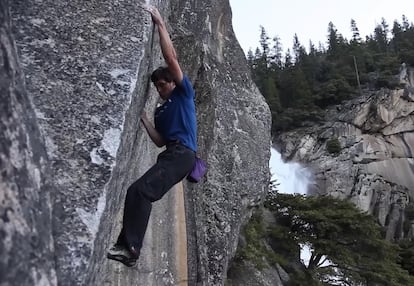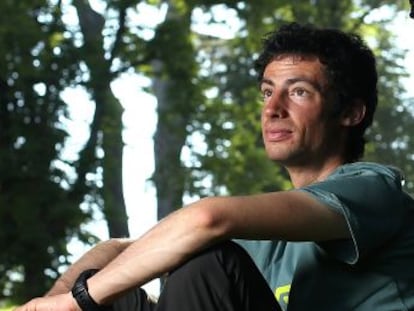Alex Honnold: Unseen video of life or death ascent of The Phoenix comes to light
Eleven years after accompanying the American climber on his toughest free solo in Yosemite, filmmaker Peter Mortimer has released the footage

In 2011, American climber Alex Honnold executed a free-solo climb (that is to say, without any ropes) of a 40-meter route known as The Phoenix, in California’s Yosemite National Park. The feat went largely unnoticed beyond specialized media. Nonetheless, never before had any climber been able to scale such a difficult route in this way. On the Yosemite Decimal System, The Phoenix is graded a 5.13a climb, one of the most difficult on the planet and the first recorded in the United States. To put its complexity into context, the vast majority of climbers never attain this level of difficulty even with the aid and protection of ropes.
Honnold rose to international prominence in 2017 when he free-soloed the Freerider route on El Capitán, also located in Yosemite: almost 1,000 meters of sheer wall without a rope. His achievement led to a 2019 documentary, Free Solo, which won an Oscar. However, none of Freerider’s 33 pitches (or sections) is as difficult as The Phoenix route. Eleven years after Honnold’s climb, production company Reel Rock has released an eight-minute short film capturing his ascent of The Phoenix, one of the most mind-blowing moments in climbing history, which causes equal parts disbelief and anxiety.
The short movie, filmed by and co-starring Peter Mortimer (director of the two greatest climbing documentaries ever made, The Dawn Wall and The Alpinist), is a horror film that frays the nerves even if we already know the ending.
The route runs almost parallel to the Cascade Falls waterfall and is famous for several reasons: firstly, its difficulty. It is an extremely technical and extra steep finger crack that exceeds 90 degrees of inclination with respect to the horizontal plane. The second challenge posed by the route is that it runs through granite, where it is difficult to get a firm foothold. Locals say that the rock is slippery, like ice, and that losing footing is commonplace. Then there is the simple fact of having to accept that when climbing without a rope, a single mistake can end your life.
The Phoenix route starts on a ledge located in the middle of the wall, which can only be accessed by rappelling down from the top. That’s what Honnold and Mortimer did at dawn that day in June 2011. Mortimer stood right at the point where The Phoenix ends while Honnold slid down the rope, checking that the route was not wet. A second cameraman stood in front of the wall. Once on the ledge, Honnold removed his harness and excess clothing, dipped his hands into a bag of magnesium, blew off the excess, and left its relative safety to face 40 meters of life or death climbing.
Mortimer has not revealed why he held on to this unique footage, in which the entire climb is recorded, for so long. Perhaps he feared a copycat effect – that climbers lacking Honnold’s physical and psychological abilities would attempt to free solo the route. Maybe Honnold’s sponsors did not want the publicity, although a few seconds of the footage appeared on CBS show 60 minutes in October 2011, during which the interviewer asked the climber why he didn’t want any more spectators that day than Mortimer. “I never would have agreed to go out there with like a bunch of people. It just would be craziness. And honestly, you guys wouldn’t want to see it. Like it would be weird.”
Mortimer can attest to that: in the footage, he appears to suffering more than Honnold. Nobody wants to witness a fatal accident. At one point, while trying to focus on the climber’s fingers searching for an anchor point on the rock, Mortimer’s hands begin to tremble and the shot blurs and is lost. Mortimer was fortunate enough to witness the feat as a logistical matter: someone had to remove the rope after the rappel and collect Honnold’s gear. Honnold is credited with over 1,500 free solo ascents, 95% of which have been carried out without cameras or an audience.
Honnold has fingers of unusual diameter: they look disproportionate and are both a huge asset and a hindrance. “I don’t think they were quite this big before I started climbing. I honestly think my connective tissue and stuff is like, gone,” he told CBS. On The Phoenix, the key pitch runs through a crack that his fingers fill with ease, facilitating his progress. But on a supposedly easier section, the crack is so thin that his fingers barely have room to embed, resulting in fatigue and the frightening possibility of slipping. Shortly after he completed the ascent, a self-critical Honnold admits to having climbed poorly, with more tension than expected. The camera, meanwhile, records purely fluid and accurate movements - and the genuine possibility of the climber’s instantaneous death.
Sign up for our weekly newsletter to get more English-language news coverage from EL PAÍS USA Edition
Tu suscripción se está usando en otro dispositivo
¿Quieres añadir otro usuario a tu suscripción?
Si continúas leyendo en este dispositivo, no se podrá leer en el otro.
FlechaTu suscripción se está usando en otro dispositivo y solo puedes acceder a EL PAÍS desde un dispositivo a la vez.
Si quieres compartir tu cuenta, cambia tu suscripción a la modalidad Premium, así podrás añadir otro usuario. Cada uno accederá con su propia cuenta de email, lo que os permitirá personalizar vuestra experiencia en EL PAÍS.
¿Tienes una suscripción de empresa? Accede aquí para contratar más cuentas.
En el caso de no saber quién está usando tu cuenta, te recomendamos cambiar tu contraseña aquí.
Si decides continuar compartiendo tu cuenta, este mensaje se mostrará en tu dispositivo y en el de la otra persona que está usando tu cuenta de forma indefinida, afectando a tu experiencia de lectura. Puedes consultar aquí los términos y condiciones de la suscripción digital.
More information
Archived In
Últimas noticias
Most viewed
- Sinaloa Cartel war is taking its toll on Los Chapitos
- Oona Chaplin: ‘I told James Cameron that I was living in a treehouse and starting a permaculture project with a friend’
- Reinhard Genzel, Nobel laureate in physics: ‘One-minute videos will never give you the truth’
- Why the price of coffee has skyrocketed: from Brazilian plantations to specialty coffee houses
- Silver prices are going crazy: This is what’s fueling the rally










































